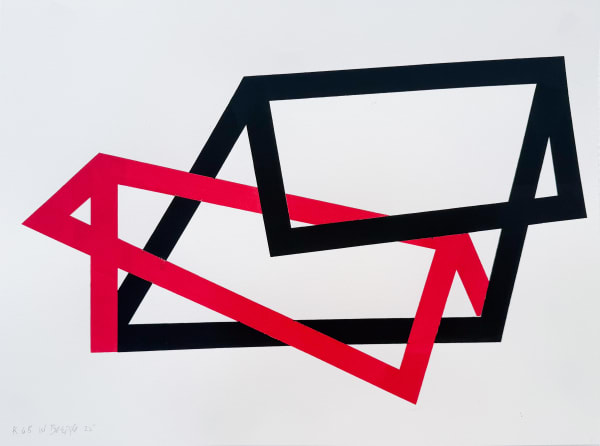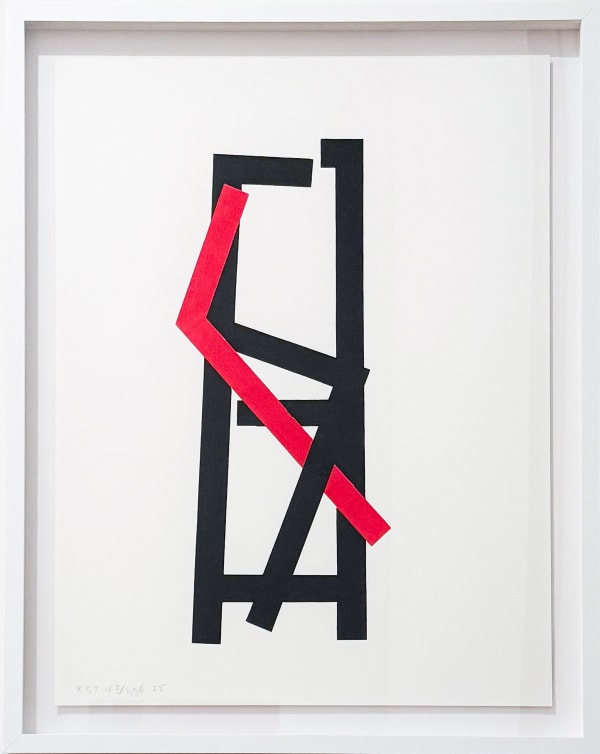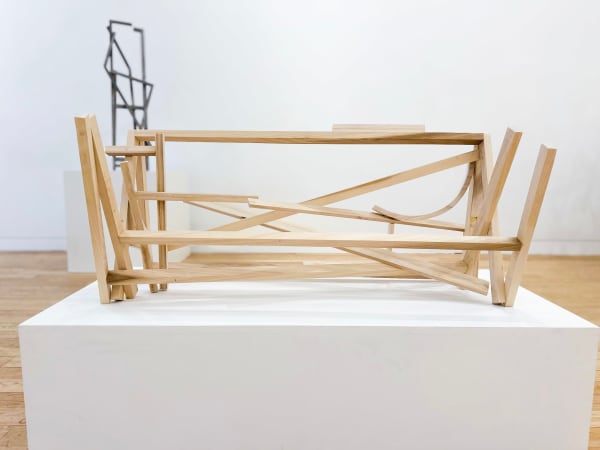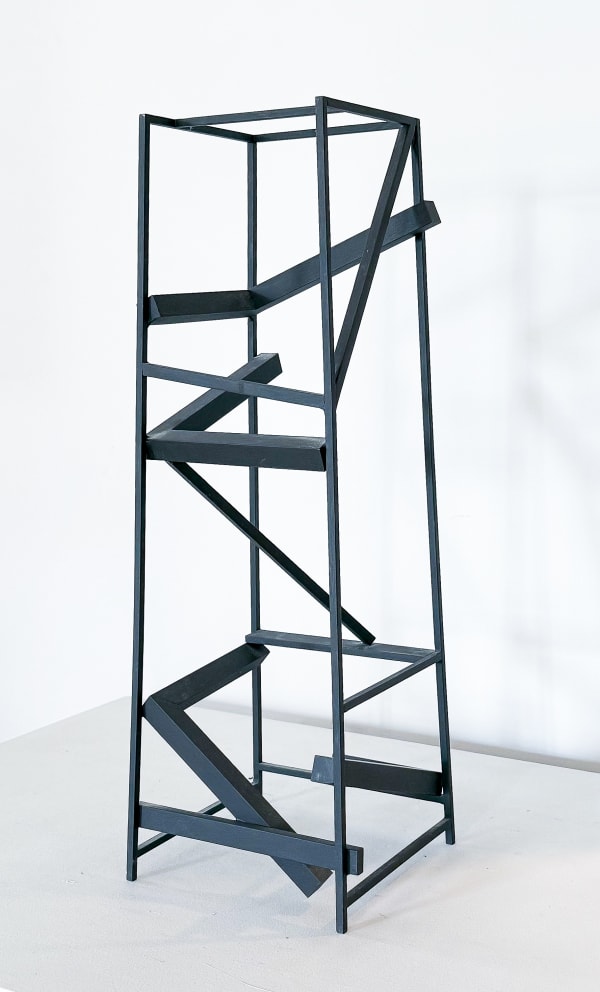Paper, Wood, and Steel: Willard Boepple
-
Works
-
 Willard Boepple, K68, 2025
Willard Boepple, K68, 2025 -
 Willard Boepple, K57, 2025
Willard Boepple, K57, 2025 -
 Willard Boepple, Keegan 19, 2025
Willard Boepple, Keegan 19, 2025 -
 Willard Boepple, Beaker 17, 2024
Willard Boepple, Beaker 17, 2024 -
 Willard Boepple, Beaker 5, 2024
Willard Boepple, Beaker 5, 2024 -
 Willard Boepple, Lean To # 3, 2024
Willard Boepple, Lean To # 3, 2024 -
 Willard Boepple, Lean To # 2, 2024
Willard Boepple, Lean To # 2, 2024 -
 Willard Boepple, Running Man Green, 2023
Willard Boepple, Running Man Green, 2023 -
 Willard Boepple, Monoprint 6, 2023
Willard Boepple, Monoprint 6, 2023 -
 Willard Boepple, Barn 10.23 - 18, 2023
Willard Boepple, Barn 10.23 - 18, 2023 -
 Willard Boepple, Barn O - 19, 2023
Willard Boepple, Barn O - 19, 2023 -
 Willard Boepple, 3.11.23 N, 2023
Willard Boepple, 3.11.23 N, 2023 -
 Willard Boepple, Barn O, 2021
Willard Boepple, Barn O, 2021 -
 Willard Boepple, 17.2.15, 2015
Willard Boepple, 17.2.15, 2015 -
 Willard Boepple, Mountain 21.2.14 I, 2014
Willard Boepple, Mountain 21.2.14 I, 2014 -
 Willard Boepple, Pony, 2025
Willard Boepple, Pony, 2025 -
 Willard Boepple, Lap, 2025
Willard Boepple, Lap, 2025 -
 Willard Boepple, Red Put, 2025
Willard Boepple, Red Put, 2025 -
 Willard Boepple, Out Roger, 2025
Willard Boepple, Out Roger, 2025 -
 Willard Boepple, Up Red, 2025
Willard Boepple, Up Red, 2025 -
 Willard Boepple, Swing, 2025
Willard Boepple, Swing, 2025 -
 Willard Boepple, Touch, 2025
Willard Boepple, Touch, 2025 -
 Willard Boepple, Red Light, 2014
Willard Boepple, Red Light, 2014 -
 Willard Boepple, Backstay, 2014
Willard Boepple, Backstay, 2014 -
 Willard Boepple, Heath, 2014
Willard Boepple, Heath, 2014 -
 Willard Boepple, Little Rhum, 1989
Willard Boepple, Little Rhum, 1989 -
 Willard Boepple, Captain Slightly , 1981
Willard Boepple, Captain Slightly , 1981
-
-
Press Release Text
New York | 23 East 67th Street
November 6, 2025 – January 3, 2026
Upsilon Gallery Presents:
Upsilon Gallery is delighted to present Willard Boepple: Paper, Wood, and Steel, opening November 6th, 2025, and on view through January 3rd, 2026. Celebrated for his abstract sculptures that balance grace, wit, and structure, Boepple’s work captures a profound sense of human experience through form and material. In the new catalog accompanying this exhibition, Karen Wilkin, Contributing Editor at The Hudson Review and regular contributor to The New Criterion and The Wall Street Journal, writes that Boepple’s works, “whether serious and elegant or playful and witty, are completely self-sufficient, idiosyncratic, and resonant with the experience of being human.” This exhibition brings together a dynamic selection of his wood and steel sculptures alongside monoprints and inks on paper, revealing an intimate dialogue between two and three dimensions of his evolving language of form.
For Boepple, the boundary between sculpture and print is porous, an ongoing exchange rather than a division. His practice is founded on the belief that each discipline continually informs the other, generating a fluid interplay of spatial and pictorial ideas. At times, a series of screenprints serves as the conceptual starting point for new sculptural forms; at others, a sculpture provides a fragment or structure that is subsequently reinterpreted in two dimensions. The artist has described these parallel practices as “brothers and sisters, born of the same origin, yet each evolving in its own way.”
In his most recent works, Boepple expands this dialogue further through the act of painting directly onto paper. Translating sculptural motifs into two-dimensional compositions, he allows shape and color to assume architectural weight. A ladder-like form from one sculpture, for instance, becomes a structural armature within a painted work, while layered transparencies on a lightbox serve as studies in spatial rhythm and chromatic tension. This recursive process underscores Boepple’s ability to reinvent form across mediums, maintaining a disciplined clarity while embracing improvisation and discovery.
Born in Bennington, Vermont, in 1945, Willard Boepple has developed a body of work characterized by precision, restraint, and continual experimentation. He studied at the University of California, Berkeley, before earning his MFA at the Cranbrook Academy of Art, where early encounters with sculptors George Rickey and Anthony Caro profoundly influenced his approach to structure and abstraction.
Boepple’s work has been exhibited extensively in the United States and abroad, with major solo presentations in New York, London, and Cambridge, UK. His sculptures and prints form part of prominent public and private collections, including the Fitzwilliam Museum (Cambridge, UK), the Hood Museum of Art (Hanover, NH), and The Metropolitan Museum of Art (New York, NY).
Over the course of his career, Boepple has been the subject of numerous essays and critical reviews in publications such as The New York Times, Art in America, The Brooklyn Rail, and Sculpture Magazine. The monograph Willard Boepple: Sculpture (2011) further situates his work within the broader context of contemporary abstraction, attesting to his enduring influence and singular contribution to the language of modern form.
Willard Boepple: Paper, Wood, and Steel will be live at Upsilon New York from Thursday, November 6th, through Saturday, January 3rd, 2026.
-
ESSAY
BY KAREN WILKINWILLARD BOEPPLE: PAPER, WOOD, AND STEEL
By Karen Wilkin
Willard Boepple makes abstract sculptures. Constructed in wood or steel, they embody a wide range of moods, but they are always uncompromising in their refusal to resemble anything but themselves. Whether serious and elegant, or playful and witty, they are completely self-sufficient, idiosyncratic, and resonant with the experience of being human. Boepple has long been fascinated by the way our environment and the things we use are shaped by the proportions and capabilities of our bodies – the distance between the steps of a ladder, the height of a table, or the position of a door knob, for example – and his works take as their point of departure those deeply ingrained givens. We recognize his allusions to commonplace furnishings that we usually consider only in terms of their utility, but he challenges our preconceptions in unexpected ways. Ladders can be translated into small, personable arrangements of robust chunks or elongated into delicate towers, at once architectural and vaguely anthropomorphic, haunted by the memory of Cubist dissections of planes. Boepple celebrates the character of his varied materials, sometimes using color to heighten our awareness of the spatial articulation and presentness of the construction before us. We focus on the individuality of a sculpture and on its internal relationships while, just as in a Cubist painting or sculpture, we acknowledge the difference between that construction and what know about its quotidian ancestors. In some recent works, we catch glimpses of sawhorses, but they are soon subsumed by a new, layered, unnamable structure. The longer we spend with Boepple’s sculptures, the more surprising they become, as we are increasingly involved in his richly allusive, distinctive language.
Boepple’s works on paper are intimately related to his works in three-dimensions. His drawings are not preparations for sculptures, but rather propose new possibilities for (sometimes tenuously) related configurations. They can even provoke us into seeing the sculptures freshly. The graphic crispness of the drawings intensifies our awareness of the way Boepple’s constructions occupy space, triggering new discoveries. As we move around his towers, for example, we see profiles that remind us, fleetingly, of images hinted at in the drawings. These brief perceptions change, when we continue our progress around the work, so that we are compelled to interrogate the drawings once again. Boepple’s monoprints, with their clear shapes, clean edges, and luminous color, are built like sculpture. The images are cumulative, the result of independent planes of transparent hues being superimposed upon each other. Hues deepen, subtly alter, or become something else entirely with repetition and where the planes overlap, in the same way that the internal shapes and volumes of Boepple’s three-dimensional works are defined by overlaps of the elements – planar or linear – with which they are constructed. Each body of Boepple’s work – sculptures, drawings, or monoprints – celebrates the properties and personality of its medium, yet whether flat or two dimensional, made of wood, steel, or paper, they reveal their family resemblances. They all bear witness to Boepple’s highly original transubstantiation of the objects of our daily lives into eloquent, compelling, wholly new structures and images that demand and reward our close attention.
Karen Wilkin
New York, October 2025
ABOUT THE CONTRIBUTORKaren Wilkin is a New York–based art critic and curator specializing in modern and contemporary art, with a focus on mid-twentieth-century modernism. Educated at Barnard College and Columbia University, and a recipient of Fulbright and Woodrow Wilson fellowships, she has organized numerous international exhibitions and written extensively on Stuart Davis, Hans Hofmann, David Smith, and Anthony Caro, among others. Wilkin serves as Contributing Editor for The Hudson Review and contributes regularly to The New Criterion and The Wall Street Journal, while also teaching at the New York Studio School. -
CATALOG

-
Biography
Willard Boepple (b. 1945, Bennington, Vermont) is an American sculptor and printmaker known for rigorously abstract yet deeply human constructions in wood, aluminum, resin, and steel. Boepple grew up in California, where he first began making art in his teens. He studied at the Skowhegan School of Painting & Sculpture, the University of California, Berkeley, and the Rhode Island School of Design, earning his BFA from City College of New York. After assisting Isaac Witkin at Bennington College, he taught at the School of the Museum of Fine Arts, Boston, and later established studios in New York and Vermont.
Influenced by the late Anthony Caro and grounded in the modernist lineage of Picasso, González, and David Smith, Boepple has developed a personal sculptural vocabulary rooted in the additive logic of joinery and the human relationship to structure. His art registers the scale of the human body and its ordinary operations, creating works that, though abstract, remain connected to human presence. Often described as “musical” and “polyphonic,” his sculptures invite viewers to move around them and to experience their unfolding logic in time and space. There is always a sense of implied movement, as if each form were caught in the midst of a gesture, yet every piece strives toward a condition of “rightness,” a poised equilibrium between tension and resolution.
Boepple’s major series, Ladders, Shelves, Looms, Temples, Towers, Rooms, and Trestles, begin from simple structural premises and evolve through variation, folding, and recomposition. The Ladders transform function into rhythm and ascent; Little Rhum (1989), for instance, turns the ladder motif into a syncopated climb, with evenly spaced uprights that read as rhythm as much as structure, placing it firmly within Ladders. From that measured cadence, the work moves to Shelves, which treat containment as a sculptural idea, holding space rather than objects and setting the stage for Looms; in Pony (2025), interlaced slats form a taut open grid that turns the weave itself into a spatial framework. Temples gather this clarity inward, compact and contemplative, while Towers lift it into vertical poise; Backstay (2014) rises through stacked members that stabilize as they ascend. Rooms articulate thresholds between architecture and abstraction, and Trestles extend the language toward motion, where engineered order inclines toward the organic. Together, the series balances clarity and complexity, discipline and intuition, precision and lyrical unpredictability.
Boepple has, since the early 1990s, used translucent resin and color as active structural agents, allowing light to reveal inner geometry and spatial rhythm. His parallel printmaking practice, developed from 2004 with the late master printer Kip Gresham in Cambridge, England, extends these concerns through layered monoprints that “build with color.” In 2023, the Shards series was presented by Upsilon Gallery, New York, as an online viewing room, a group of wall mounted reliefs that merge sculpture and print and intensify the dialogue among structure, color, and perception.
Boepple was elected to the National Academy in 2010 and became a Fellow of the Royal Society of British Sculptors in 2001. He has also served on the boards of the National Academy of Design and the Vermont Studio Center. His monograph Willard Boepple: The Sense of Things (Lund Humphries, 2014), with essays by Karen Wilkin and a foreword by Michael Fried, offers the most comprehensive study of his work, situating it within modernist abstraction while underscoring his distinct contribution.
Collections, Honors, and Institutional Presence
Boepple’s work is represented in numerous major public and private collections. Among them:
-
Metropolitan Museum of Art, New York (e.g. Eleanor at 7:15)
-
Museum of Fine Arts, Boston
-
Storm King Art Center, NY
-
Fitzwilliam Museum, Cambridge, UK
-
National Gallery of Botswana, Gaborone; National Gallery of Kenya, Nairobi
-
National Academy (New York)
-
Hepworth Wakefield (UK)
Recent Exhibitions and Developments
-
2023: Shards (Upsilon Gallery, New York) — 7 wall-relief works from 2021–22 fusing sculpture and monoprint strategies
-
2020: Wood and Paper: Sculpture and Prints (Pamela Salisbury Gallery, Hudson, NY)
-
2019: Willard Boepple — Monoprints (Aleph Contemporary)
-
2018: Built and Printed (Cynthia Reeves / MASS MoCA Way, North Adams, MA)
-
2017: 2+3D: Prints & Sculpture (FX Fowle Architects Gallery, New York; also at Broadbent, London)
-
2016: Willard Boepple: Sculpture (John Davis Gallery, Hudson, NY)
-
2015: Willard Boepple: The Sense of Things (Maddox Arts, London) in parallel with publication of monograph
-




























